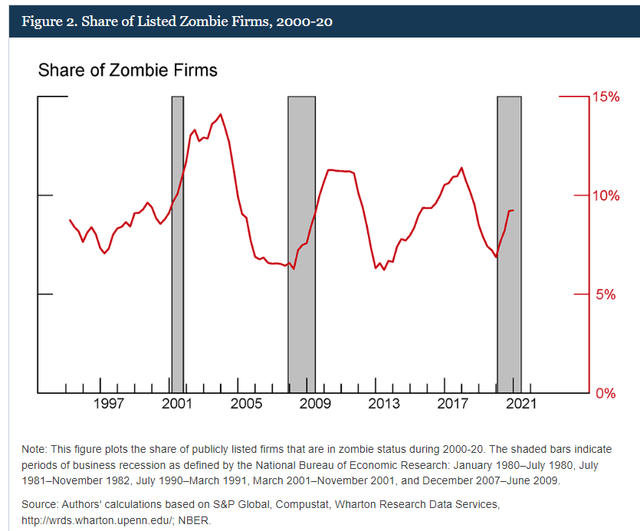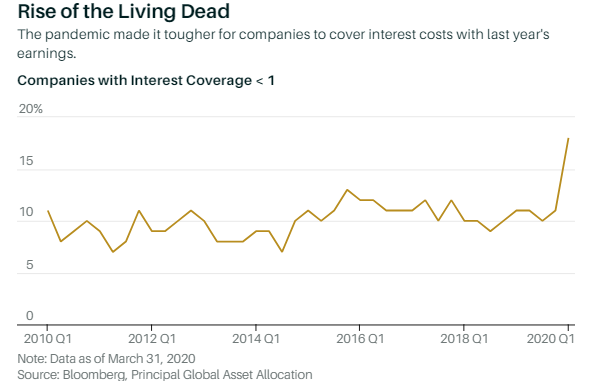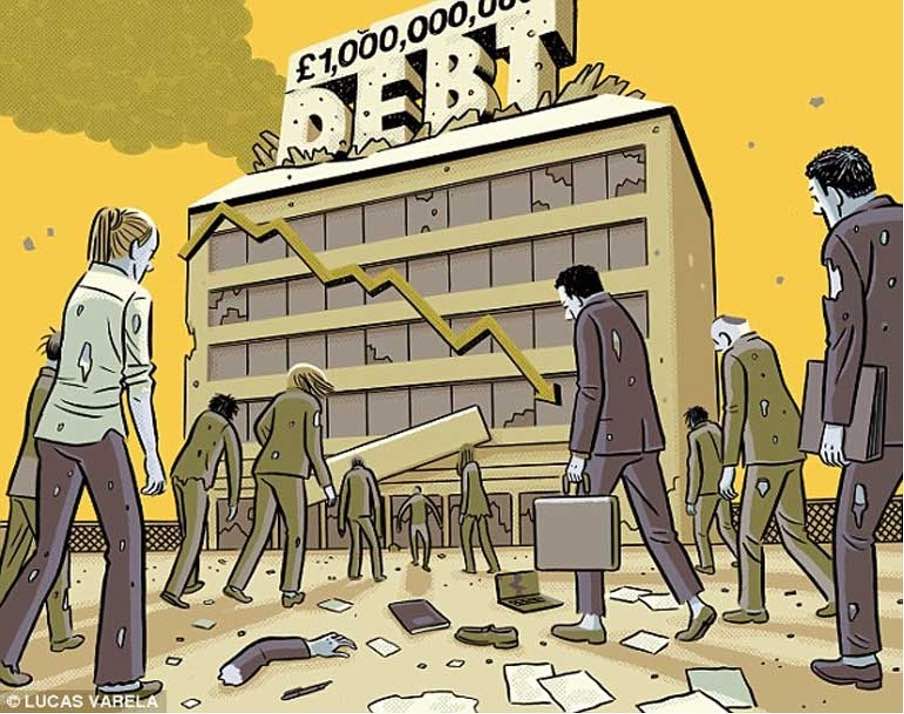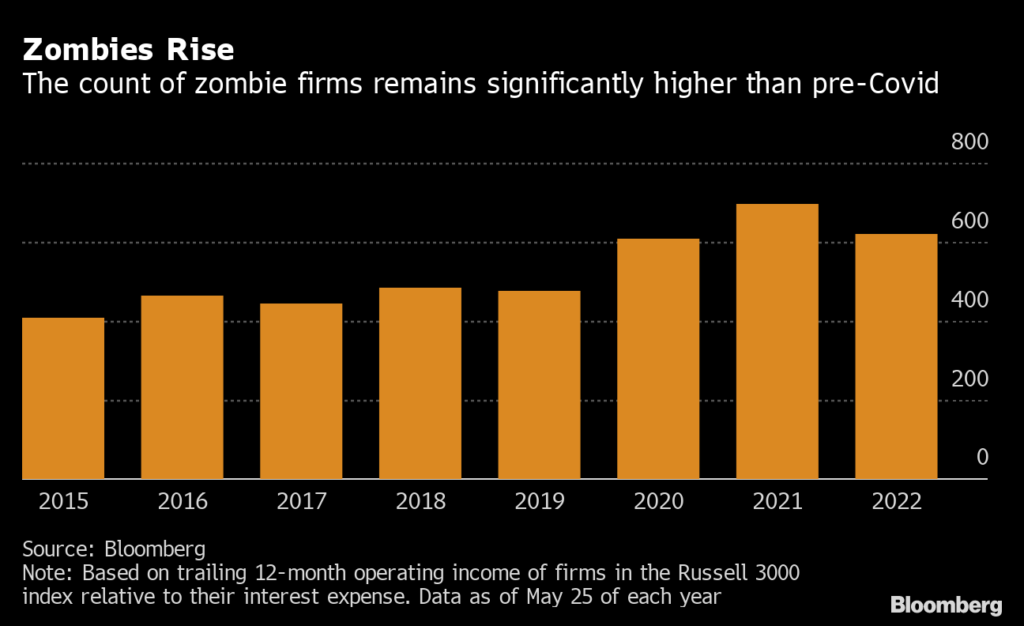Halloween has passed, but the investors who are spooked by the rise of the living dead. And no, I’m not talking about the brain-eating morbid creatures depicted in the movies, I’m referring to every investor’s nightmare- Zombie Companies. They seem dead. They are eating away all the country’s economic growth. And they are increasing in numbers. Sadly, this will be the only kind of apocalypse we’ll get to live through. I guess.
So, what are zombie companies?
Well, in the corporate world, this term is used for distressed companies that continue to operate despite being in a financially precarious or unsustainable state. These businesses barely make enough money to cover their operational expenses and are so indebted that, most of the time they are only able to repay the interest on their debts but not repay the principal amount.

People define these as firms not generating enough earnings before interest and taxes (EBIT) to cover their interest payments for multiple years in a row. But this definition captures lots of younger and fast-growing firms who in spite of not being able to repay their current interest can refinance; companies like Tesla for instance. Thus, it becomes difficult for investors and other lenders to identify zombie firms which consequently leads to misallocation of resources.
In layman’s language, they are the perpetually loss-making companies surviving on cheap credit and government aid. These sources of funds are basically their life-support. Such businesses either restructure or go out of business. But zombies just keep staggering along, tenuously alive, and some researchers worry that they act as a drag on the entire economy by using up resources that could be better spent elsewhere.
They pose a threat to economic growth because they tie up valuable resources, including capital, labour, and managerial talent. These undead firms often lack the incentive and ability to innovate. They tend to focus on survival rather than investing in research and development or adopting new technologies. This can stifle overall technological progress and limit the development of new industries and products that could drive economic growth.
Zombie firms can distort competition in the market. Since they can continue to operate despite their financial weaknesses, they may engage in predatory pricing or other anti-competitive practices that harm healthier competitors. This stifles market competition, which is typically a driver of innovation and efficiency.

They also tend to have lower productivity levels because they may not invest in improving processes or technologies. This can drag down overall productivity growth in an economy, which is a critical driver of long-term economic expansion.
So, now that you have gotten an idea of how these companies impact our economy, let us understand how they originated and are growing in numbers.
The term ‘Zombie company’ originated and gained prominence in Japan during the 1990s when many Japanese firms, particularly in the real estate and construction sectors, were heavily indebted and unable to generate sufficient profits. These companies were propped up by banks and government support, which prevented them from going bankrupt but also hindered economic recovery. This resulted in a significant slowdown in Japan’s previously bustling economy which lasted from about 1991 to 2001. This dark phase of Japan’s economy is also known as “The Lost Decades”.

Later on, the 2008 global financial crisis led to the emergence of zombie banks and financial institutions that were kept afloat with government bailouts and central bank support. These institutions were burdened with toxic assets but continued to operate with government assistance. Countries like Belgium, Finland, France, Italy, Korea, Slovenia, Spain, Sweden, and the UK saw a rise in zombie firms. The continued existence of these firms was bad for the economy as it prevented new companies from entering the market and more productive firms from expanding. This gave rise to slacking productivity growth as these firms were claiming market share that someone else could make better use of.
In 2021 Goldman Sachs reported that some 13% of U.S.-listed companies “could be considered” zombies, which it called “firms that haven’t produced enough profit to service their debts.” The Federal Reserve study found that only roughly 10% of public firms were zombie companies in 2019. Finally, a Deutsche Bank study by Jim Reid in 2021 that found that over 25% of U.S. companies were zombies in 2020.
Similarly, a study conducted by the International Monetary Fund (IMF) found that zombie firms are a persistent issue globally. The study revealed that 60 to 80 per cent of zombie firms remain in a zombie state, whether they are listed or private firms. This indicates that these financially distressed companies struggle to recover and operate successfully.
While these undead companies were a major cause of concern throughout the decades, the issue with these firms gained more attention during and post the COVID-19 pandemic.
We are all already aware of how COVID-19 prompted widespread lockdowns, travel restrictions, and reduced consumer activity. This led to many businesses, especially those in industries like hospitality, tourism, and small retail, facing a sudden and severe drop in revenue. As revenues plummeted, numerous companies struggled to meet their financial obligations, including rent, loans, and employee salaries. As a result, many businesses faced problems like mounting debt and financial distress.

So, the Government stepped in, like a good Samaritan to save these struggling companies from going bust by encouraging banks to inject millions of dollars into the economy at dirt-cheap rates. This is also known as Quantitative Easing (QE) and is used by central banks to facilitate economic recovery. While that move on the Government’s part did bail out a lot of companies and prevented immediate layoffs, simultaneously, it also contributed to a rise in the number of zombie firms- these firms were sucking up the vital lifeblood like government aid and other resources which could have been spent on more efficient and productive companies.
Then again, the problem arises of how should an investor or the lending bank accurately identify a zombie company to prevent inefficient allocation of funds. They typically use debt ratios like Interest Coverage Ratio (ICR) to determine a firm’s ability to pay off its debt. The lower the ratio, the riskier it is to lend money to such companies. But at times of economic crisis when most businesses start to fail, it becomes difficult to distinguish between a zombie firm and a normal firm that is struggling. Every company is in need of corporate credit and financial aid and in such a small amount of time, predicting which company will survive from that funding and which won’t, is another dilemma. So, when money is injected into the economy, zombie firms start to benefit from this.
Investing money in a zombie firm is a choice that most investors regret because of high-risk exposure and low profitability along with missing out on more promising ventures that could have generated higher returns.

Rise of Zombie companies in India
The rise of zombie firms in India has been a concerning trend. According to a report the share of zombie firms in India doubled between the financial years 2012 and 2022. The share of zombie firms as a percentage of listed companies has risen from 4.9% to 9.8%. In fact, it has been estimated that zombie firms take away 10% of loans in India; leaving the healthier firms starving for credit.
The presence of zombie firms has led to a rise in duopoly in core infrastructure business sectors like telecom and aviation.
In the telecom industry companies like Reliance Jio and Bharti Airtel Ltd are benefiting from struggling companies like Vodafone Idea. VI is turning into a zombie company as it is unable to pay off its debts and has been losing its customers, thereby struggling to compete in the market; which has allowed its rivals to gain an upper hand by increasing their market share and expanding their customer base. The rise of zombie firms like Vodafone Idea creates an opportunity for dominant players like Reliance Jio to further strengthen their position in the telecommunications industry and exploit consumers by raising price levels.
A similar situation is arising in the aviation sector. Go Airlines India Ltd., with a 7% domestic passenger share which had filed for bankruptcy in early May, has temporarily grounded its flights. Its competitors- IndiGo, which controls 63% of the Indian market and Air India Ltd., privatized in 2021, benefit from this situation.
The government is trying to implement stricter bankruptcy and insolvency laws to mitigate the negative impact of zombie firms on the economy.
Lately, the interest rates are being hiked up by central banks across the globe to tame inflation. Some sources suggest that this could trigger a broader financial crisis because if a large number of zombie companies simultaneously face financial stress due to their increasing debt servicing costs and lower access to credit, they can default on their debts causing huge losses.

Conclusion
While providing cheap credit to zombie firms has its negative consequences, the lack of the same can also be equally detrimental to the economy. Thus, it can be said that balancing is the need for economic stability, along with responsible lending practices- both of which are a complex challenge for banks and regulators.
Written by – Shambhavi Gupta
Edited by – Khalid Khursheed




